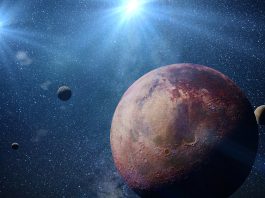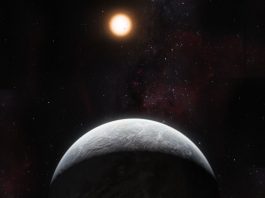Scientists have identified a new class of habitable exoplanets that may potentially support life, despite being vastly different from Earth.
The novel class of habitable exoplanets, discovered by a team of astronomers from the University of Cambridge, has been named ‘Hycean’ planets, characterised as hot, ocean covered planets with hydrogen-rich atmospheres, which may be the right recipe of conditions for supporting life. This type of habitable exoplanet is relatively abundant in the Universe and more easily observable than Earth-like planets.
Traditionally, astronomers have hunted for signs of life on potentially habitable exoplanets that are of a similar size, mass, temperature, and atmospheric composition to Earth. However, the researchers believe that Hycean planets may present a promising candidate for sustaining life, with the team proclaiming that their findings may lead to the discovery of biosignatures beyond our solar system within the next three years.
Dr Nikku Madhusudhan, the leader of the research from Cambridge’s Institute of Astronomy, said: “Hycean planets open a whole new avenue in our search for life elsewhere.”
Their research is published in The Astrophysical Journal.
The quest for habitable exoplanets
Since the first discovery of an exoplanet nearly 30 years ago, astronomers have discovered thousands of the enigmatic astronomical bodies, the majority of which are of similar size to Earth and Neptune, leading them to be labelled as ‘super-Earths’ or ‘mini-Neptunes’. These exoplanets are predominantly rocky, or ice giants comprised of hydrogen-rich atmospheres.
Most mini-Neptunes are over 1.6 times larger than Earth, making them smaller than Neptune but too big to have rocky interiors like Earth, with prior studies identifying the pressure and temperature beneath their hydrogen-rich atmospheres are too high for supporting life.
Identifying a new classification
For their new exoplanet investigation, the team analysed a mini-Neptune called K2-18b, discovering that this planet may support life in certain conditions. This finding sparked a comprehensive investigation into the full planetary and stellar properties for which these conditions are possible, what exoplanets may have these conditions, and whether their biosignatures are detectable.
The study led to the unearthing of Hycean planets, comprised of hydrogen-rich atmospheres with vast oceans below that may support microbial life, similar to some of Earth’s most extreme aquatic environments. These potentially habitable exoplanets are up to 2.6 times larger than Earth, with atmospheric temperatures that rise as high as 200°C, although their oceanic conditions may be similar to those on our planet. Such potentially habitable exoplanets also include tidally locked ‘dark’ Hycean worlds that may only have conditions for life on their permanent night sides and ‘cold’ Hycean worlds that receive little radiation from their stars.
Furthermore, Hycean planets allow for a more considerable goldilocks zone – an area in which conditions are just right for supporting life – compared to other classes of Earth-like planets. This means that life may potentially thrive on these potentially habitable exoplanets despite being situated outside of the range where a planet similar to Earth would need to be for organisms to flourish.
Despite Hycean planets being quite common among the exoplanet population, until now, they have not been studied nearly as much as super-Earths, which means that life beyond our solar system may have been hiding in plain sight all along. However, size alone cannot distinguish a Hycean planet, with mass, temperature, and atmospheric properties also needing to be accounted for to be a potentially habitable exoplanet.
The first step that astronomers take when investigating what these conditions may be on an exoplanet is determining whether the planet resides within the habitable zone of its star; they then search for molecular signatures to uncover its internal and atmospheric structure, which illuminates surface conditions, ocean presence, and potential for life.
Additionally, astronomers search for specific biosignatures that indicate life, such as oxygen, ozone, methane, and nitrous oxide, as well as biomarkers such as methyl chloride and dimethyl sulphide that may be indicators of life on planets with hydrogen-rich atmospheres where ozone or oxygen may not be present.
“Essentially, when we’ve been looking for these various molecular signatures, we have been focusing on planets similar to Earth, which is a reasonable place to start,” said Madhusudhan. “But we think Hycean planets offer a better chance of finding several trace biosignatures.”
“It’s exciting that habitable conditions could exist on planets so different from Earth,” said co-author Anjali Piette, also from Cambridge.
Future detections
The researchers discovered that they could utilise future spectroscopic observations to detect trace terrestrial biomarkers that are expected to be present in Hycean planets, as the larger size, higher temperatures, and hydrogen-rich atmospheres of these potentially habitable exoplanets make their atmospheric signatures more detectable than Earth-like planets.
The team have now distinguished a considerable amount of potential Hycean worlds that are ideal candidates for analysing with next-generation telescopes, such as the James Webb Space Telescope (JWST) that will launch later this year. All of these possibly habitable exoplanets orbit red dwarf stars and are situated between 35-150 light-years away from Earth, with K2-18b set to undergo an examination with the JWST.
“A biosignature detection would transform our understanding of life in the universe,” said Madhusudhan. “We need to be open about where we expect to find life and what form that life could take, as nature continues to surprise us in often unimaginable ways.”









